JHP Newsletter - 2015, No. 3, 3 July
Greetings from the Greenstone/Logan Lake Resource Management Area, south of Kamloops, British Columbia. I've had a very interesting and exciting May and June!
Technique: Using a Higher ISO
While in Yellowstone in May, I started using a higher ISO than I've ever used before in order to get a faster shutter speed to stop action because I decided that capturing special behavior, like bear cubs sparring, outweighed the increased noise. So, for my Canon EOS 1D X, while I had been using ISO 800 as my maximum and then leting the shutter speed go really slow in some situations, I started to use up to ISO 3200. The noise at ISO 3200 isn't too offensive on a subject's fur or feathers, but I run noise reduction using ACR (Adobe Camera RAW) for the background where it becomes very ugly to my eyes. The noise at ISO 1600 is acceptable on a subject's fur or feathers, and I still run noise reduction on the background to clean it up.
The amount of noise allowed in an image is a matter of personal taste, and tastes can change. I based my initial ISO limit on a static subject and was quite happy getting a lower percentage of keepers for wildlife subjects not moving too much in low light. However, I was very unhappy getting almost no keepers for wildlife subjects demonstrating energetic behavior in extremely low light. Maybe it's time for you to re-evaluate your sensitivity to noise.
Tour: Tanzania II in August 2016
Join me for a 15-day photo safari to Tanzania in August 2016 where we will visit two of the lesser-known parks in Tanzania to view and photograph wildlife: Selous Game Reserve and Ruaha National Park. We will be there during the dry season so wildlife will congregate near water features, and African wild dog pups will be at their dens. These parks are off the beaten path so there won't be many, and maybe not even any, wildlife jams like you would encounter on the safari circuit in northern Tanzania. We will see several species that aren't on the typical East Africa safari circuit: roan and sable antelope, yellow baboon, and greater and lesser kudu. Because this is an exploratory tour, participants will go at cost.
Travel: Yellowstone National Park, Wyoming, USA
I went to Yellowstone National Park at the end of the first week of May, and the first week I was there it wasn't very interesting or exciting. I wasn't seeing as many bears as usual and I wasn't getting any good photo ops. I considered leaving, but because I didn't really know where else to go at that time of year, I stayed and it turned into one of my best visits ever! I stayed the whole 30 days allowed in the campground, and my partner Jan joined me for ten of those days.
One set of subjects that I photographed a lot was this black bear (Ursus americanus) sow with three yearling cubs. They're the ones made famous by the video of them getting trapped by people on the Yellowstone River bridge. She is a great mom and is quite tolerant of people as long as the people are behaving themselves and are not acting aggressively. In this image (below L), she and one of her cubs are waiting for John Kerr, the bear-whisperer and ranger extraordinaire, to make a space in the wall of paparazzi so they could cross the road. Less than a minute after I made this image, John had everyone move away from the bears' likely path and the bears crossed the road and went on their way. Several days later, I photographed two of her cubs playing (below R).
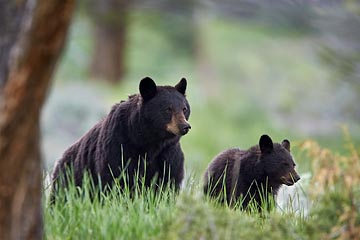
1/250 sec, f8, ISO 1600
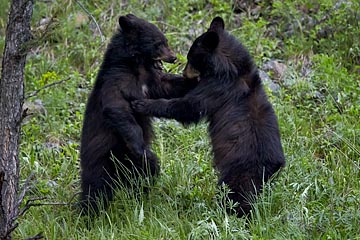
1/125 sec, f5.6, ISO 3200
Black bears can range from black to white with shades of dark chocolate brown, light brown or cinnamon, and blonde in between. Almost all black bears in the eastern United States are black, but only about 50% of the black bears in the Rocky Mountains are black.
The black bear sow and two chocolate cubs of the year (COYs) or spring cubs pictured below L were the first bears I saw on this visit to Yellowstone National Park. They didn't give me a good photo op at that time and I didn't see them again for two weeks. I was able to get some nice images of them then, but the next morning I got some great images of them when they came down the treed hillside, crossed the road, and the sow drank from the seasonal pond. After she finished, they turned around and walked towards the paparazzi (below L) before deciding that it would be better to head the other way for some privacy. It's unusual for all cubs in a litter to have the same non-black coloration here in Yellowstone, so this family is quite special and I was thrilled to have such a nice opportunity with them.
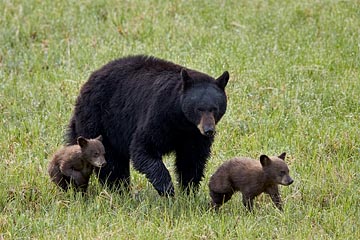
1/350 sec, f8, ISO 640
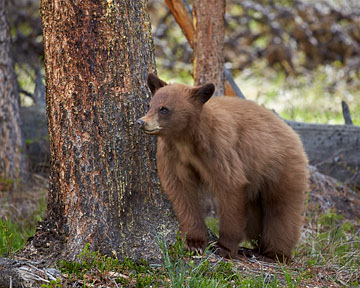
1/350 sec, f5.6, ISO 640
One of the nicest bears to photograph was this cinnamon yearling cub (above R) because of its beautiful color. Its sibling is black and that's a common split in my experience.
Cubs of the year (COYs) or spring cubs are just so darn cute in May when they're starting to learn how to be bears. The one in the image below L is at least 100 ft (30m) up a pine tree. Black bears are very good tree climbers, and usually climb trees to escape danger. The black bear yearling cub in the image below R was startled by the noise from my camera when I began to photograph it, and fortunately it gave me a much better photo op peering around the tree than it had on the ground nearby.
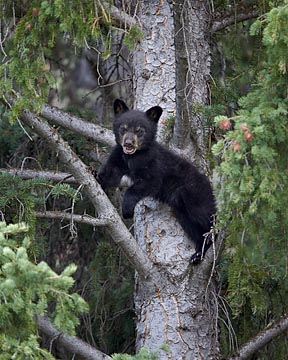
1/125 sec, f8, ISO 1600
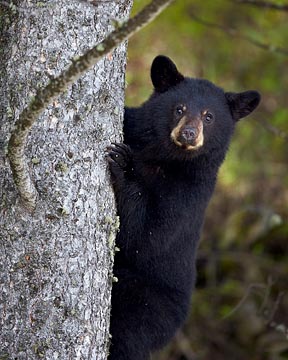
1/350 sec, f4, ISO 640
I didn't see as many grizzly bears in the park this year, partly because I spent most of my time where black bears are more common. I did have one great grizzly bear (Ursus arctos horribilis) encounter and photo op though. I saw the bear jam ahead and stopped to figure out the situation before getting into position to photograph him when he came into a nice setting for photography (below L).
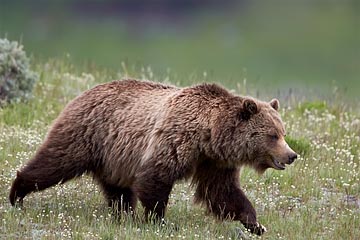
1/1000 sec, f8, ISO 1250
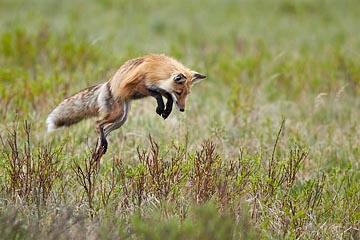
1/1500 sec, f5.6, ISO 800
I photographed a very tolerant red fox (Vulpes vulpes or Vulpes fulva) around Tower Junction on several occasions. On one occasion, I photographed it for about an hour as it hunted for voles (above R). It caught three and ate one on the spot, taking the other two back to its den and likely kits.
At the end of May, a friend told me about a red fox den in another area of the park and I spent a lot of time there with the vixen and her five kits. In the image below L, the kits are nursing and one of the kits has finished and is poking its head out. On another day, one of the kits posed like a perfect model (below R).
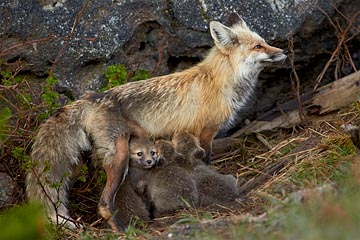
1/250 sec, f5.6, ISO 800
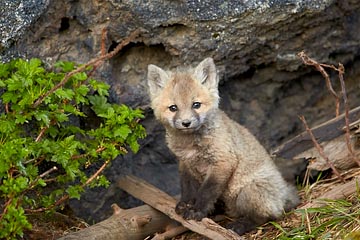
1/250 sec, f5.6, ISO 2000
Bison (Bison bison) calves are another common subject, and one afternoon a large bison herd decided they had to be in another area in a hurry and I was able to photograph this cow and her calf running (below L). I usually don't photograph bison bulls in the spring because they're rather scruffy looking as they shed their winter coats. However, when I saw this guy (below R) accessorizing with piece of sagebrush, I just had to photograph him.
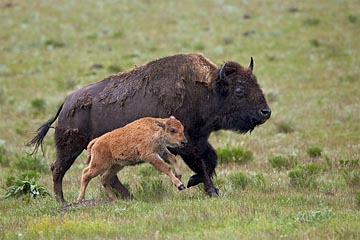
1/1000 sec, f5.6, ISO 500
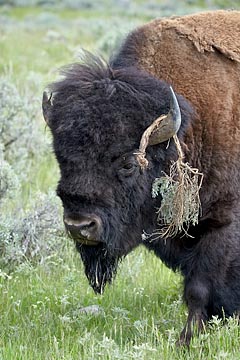
1/180 sec, f5.6, ISO 320
Pronghorns (Antilocapra americana) are also having their babies in May, and I had some very good encounters with days-old fawns. In the image below L, the doe had just collected her two fawns from their dispersed hiding spots in order to nurse them. Pronghorns are the fastest land animals in North America, and by using a slow shutter speed I was able to give a sense of speed as a days-old fawn ran through the sagebrush (below R).
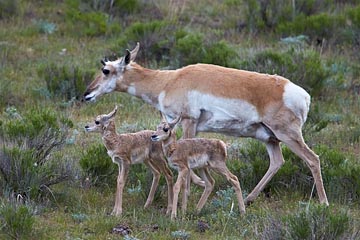
1/125 sec, f8, ISO 1250
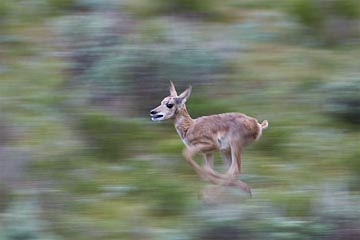
1/45 sec, f8, ISO 400
I spent some time photographing American pika (Ochotona princeps) on this visit. In the image (below L), it's eating some grass at the edge of its scree slope. I found a very tolerant American badger (Taxidea taxus) and photographed it on three different occasions (below R).
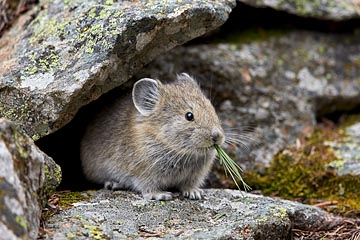
1/125 sec, f8, ISO 1600
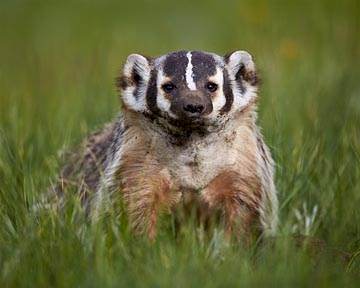
1/2000 sec, f4, ISO 250
Uinta ground squirrels (Urocitellus armatus) probably aren't near the top of any wildlife photographer's wish list, but when I saw this one perched atop a small rock (below L), I just had to photograph it. A cooperative bald eagle (Haliaeetus leucocephalus), however, probably is high on the wish list, and this one (below R) was fishing at a lake and made several excursions from its perch that were all unsuccessful before the light got too harsh and I left.
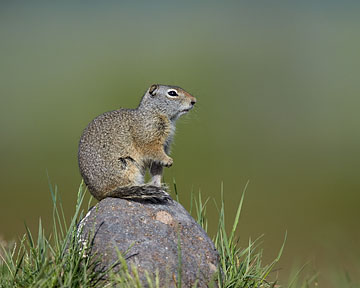
1/4000 sec, f5.6, ISO 800
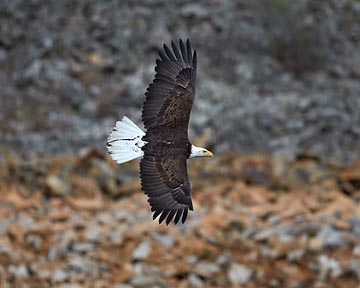
1/4000 sec, f5.6, ISO 800
One of my favorite landscape subjects in Yellowstone involves fog. Early on, I photographed fog rolling among evergreens on a hillside (below L) and towards the end of my visit I photographed evergreens enveloped by fog (below R).
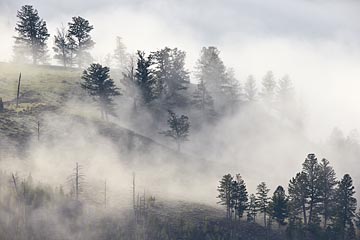
1/750 sec, f8, ISO 250
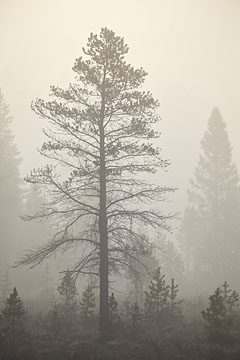
1/750 sec, f6.7, ISO 100
Travel: Lac Le Jeune Provincial Park, British Columbia, Canada
My partner, Jan Forseth, had been looking forward to going to Lac Le Jeune Provincial Park, British Columbia, Canada to photograph the loons for years and had gotten her own kayak this past February to get ready for the visit. I was dreading the visit to Lac Le Jeune in June because I would have to rent a kayak to photograph the loons because the last thing I wanted was a kayak of my own to haul around. When we arrived, we discovered that the kayak rental place at the lake doesn't open until July, so we had to go up to Kamloops (love that name!) to rent a kayak for me. True Outdoors had a nice model, a Wilderness Systems Tsunami 120, that would work well for a camera platform, so I rented one for two weeks with an option to bring it back early. I built a quick-and-dirty camera mount out of 2x4 lumber to support my long lens on a Wimberley Head and had a ball photographing the loons.
The rental kayak was working out so well that after two days I went back into town to buy one. Unfortunately, both of the Tsunami 120 models in the store had had deposits placed on them, and I didn't think the slightly larger Tsunami 125 model that was available would work. I went back to the lake very disappointed, but decided that the larger model would work better than purchasing the beaten-up kayak that I was renting. So I went back to town the next day and bought a Wilderness Systems Tsunami 125 and a Werner Skagit CF IM paddle. Because the deck ahead of the cockpit is slightly higher on the 125 than on the 120, I made a new camera mount out of 2x2 and 1x4 lumber to support my long lens on a Wimberley Head. Here's my fantastic kayak and camera mount (below L). Since Jan Forseth took that picture, I added some more bevels to the mount and painted it camo green so it blends in better with the bright red kayak. :) Jan loves her sit-on-top kayak, and I made a camera mount for her long lens during our stay at Lac Le Jeune (below R). I've designed an improved camera mount for her but have not built it yet.
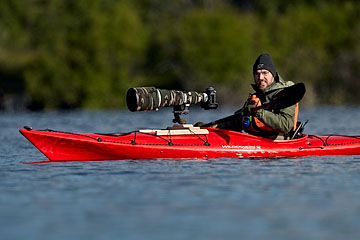
1/5000 sec, f7.1, ISO 800, © Jan Forseth
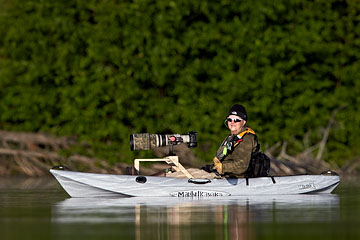
1/2000 sec, f8, ISO 500
The camera mounts in both images above are in the shooting position which is slightly aft, but we still need to lean forward to look through the viewfinder. That gives us a slightly lower perspective and it provides some room to maneuver the kayaks. Because shooting is restricted to a narrow window straight ahead of the kayak, there is a lot of maneuvering required to follow the subject when it moves. The camera mounts can be pushed forward to provide more room to paddle while going from the launch area to the subject. Also note that we don't mount the camera before getting into the kayaks because they would be very unstable. Fortunately, there was a floating fishing pier next to the beach where we launched our kayaks, so we would place our cameras on the pier, launch the kayaks, then paddle over to the pier to get the cameras.
The common loon (Gavia immer) chicks hatched early this year so they were already getting big by the time we got there in the middle of June. Chicks start to ride on their mother's back shortly after they hatch for safety. They were still riding on their mother's backs when we got there (below L), but they had started to swim along on their own too. It was very interesting, and educational, to watch the loon parents care for their chicks. When the chicks were really young, the parents seemed to feed them continually at spread out intervals. As the chicks got older, the parents would feed them a lot for a while and then let them rest. And the older the chicks became, the more the parents started to teach the chicks how to hunt on their own. The image below R was made in the middle of our stay during a feeding session, but the parent didn't have anything to feed the chick on that approach.
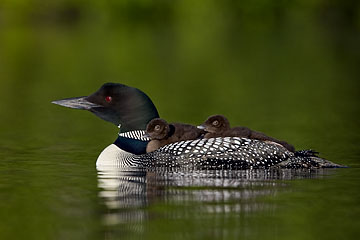
1/1000 sec, f8, ISO 640
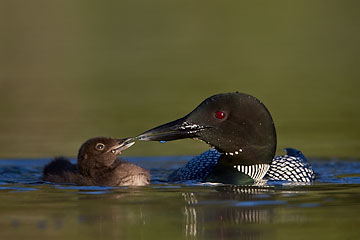
1/1000 sec, f8, ISO 640
It was a real challenge to get a great image of a parent feeding a chick because so many factors had to come together. We spent most of our time with one particularly tolerant pair of loons, but half of their lake-shore territory was lined with bleached out deadfall that created bright reflections and would be distracting in an image. So, one of the big things I sought out was a good environment. I also wanted an image where the parent and chick were coming together both perpendicular to me. I finally got my best image on one of our last days (below L), but the parent's head is turned slightly away.
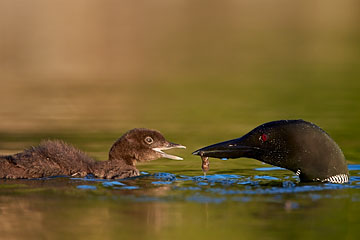
1/1000 sec, f8, ISO 1600
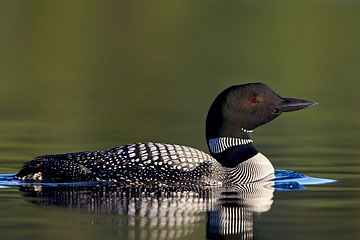
1/500 sec, f8, ISO 500
Towards the end of our two-week stay, I started to photograph the male loon during the "nap times" after the feeding sessions when the female would stay with the chicks fairly close to shore and the male would head out towards the middle of the lake. On one calm morning, the male swam through a beautiful green reflection while creating a bow wave (above R). On another morning, he stretched his wings (below L) prior to taking off.
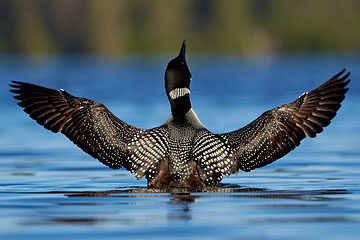
1/1500 sec, f8, ISO 500
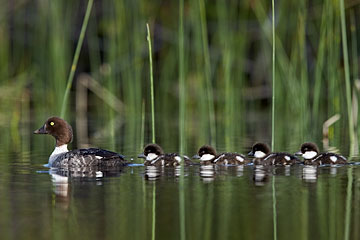
1/750 sec, f8, ISO 800
One morning after leaving the loons, I found a common goldeneye (Bucephala clangula) with four chicks, They were skittish at first but eventually settled down and I was able to get some nice images including this one (above R) of them swimming in a line.
Take care and happy shooting.
— James
James Hager Photography :: www.jameshagerphoto.com




